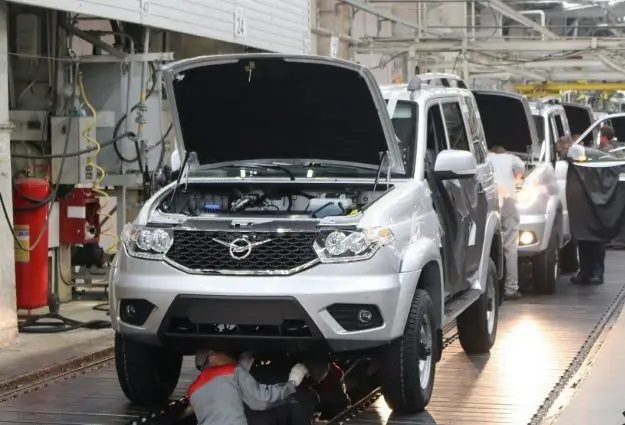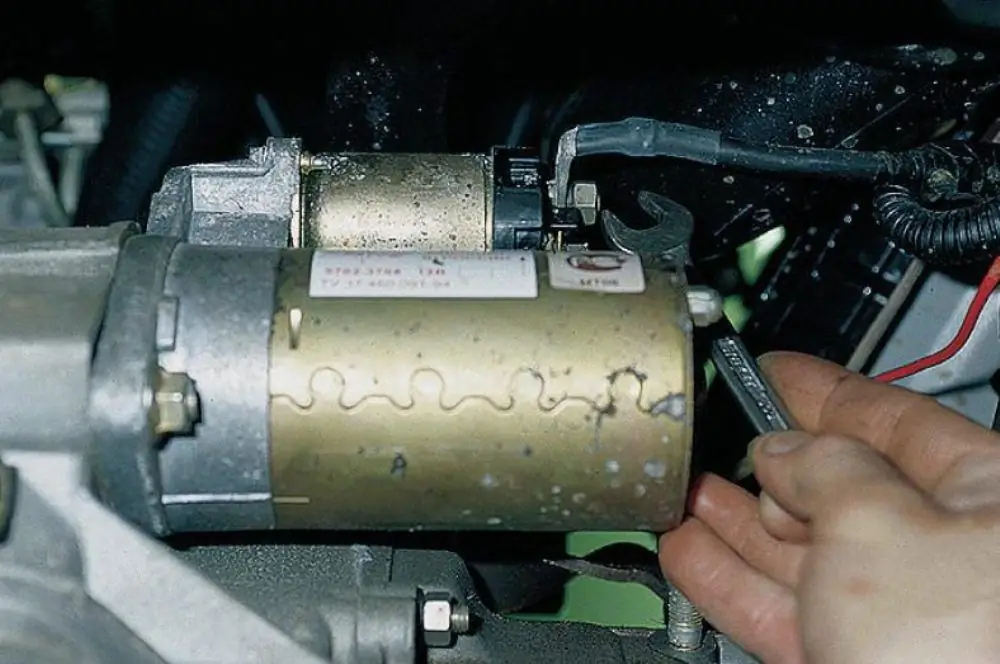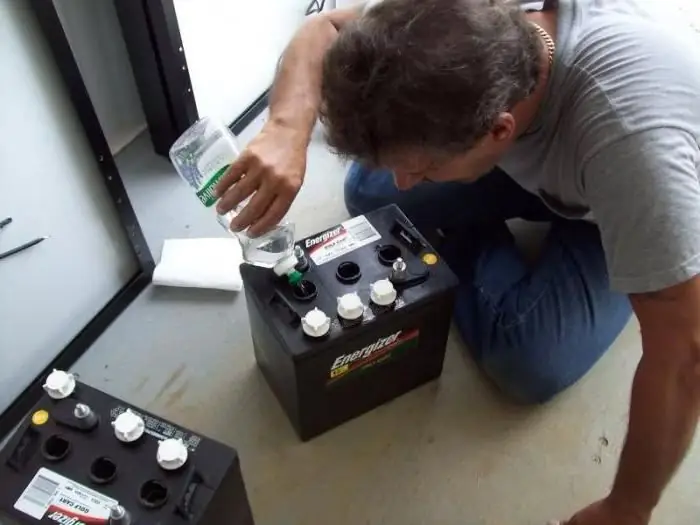2025 Author: Erin Ralphs | [email protected]. Last modified: 2025-01-22 21:14:09
Starter batteries are used in cars as energy sources. Electricity is needed to start the internal combustion engine and power all consumers. Tractors and automobiles use two types of energy source. This is a battery and an electric generator. The battery provides energy to the starter when starting the engine and consumers. The battery compensates for the lack of energy when the generator has not yet come into operation. Therefore, the battery is called as a starter battery. There are also traction batteries, but they are needed for other tasks.

From history
The first full-fledged battery was created in 1859 by the French inventor Plante. The device consisted of two sheets of lead rolled into a spiral, separated by a separator. These sheets were immersed in a sulfuric acid solution. The battery had a total active electrode area of 10 m2. After improvements and upgrades, the battery was launched into mass production in1880. Later, Volkmar created grating plates from lead-antimony alloy, which gave birth to a new battery era. However, it was not until 1925 that an electric starting system was first used on cars.
Operation principle
The simplest lead battery is a plastic vessel with an electrolyte inside. There are two plates in the vessel. These are battery electrodes. The electrolyte is a solution of highly purified sulfuric acid and distilled water. The active substances during the passage of electrochemical processes are lead dioxide on the positive plate, as well as spongy lead on the negative. The electrolyte of a charged battery has a higher capacity.

The battery works on the basis of the principle of double conversion: first, electricity from third-party sources is converted into chemical energy, then chemical energy is converted into electrical energy. The battery is not an independent power source, but only accumulates and converts electricity.
Under the influence of current, sulfuric acid, which is contained in the composition of the electrolyte, decomposes. Hydrogen is released from it, which subsequently combines with oxygen released on the positive plate. The combination of hydrogen and oxygen produces water. Lead combines with what is left of the acid, resulting in lead sulfate.
Together with chemical transformations on the positive plate, when the battery is discharged, the chemical composition of the negative one also changes. Thus, spongy lead combines with the rest of the acid, and lead sulfate is formed.
Design
A lead-acid battery, as a reversible source of electric current, structurally consists of a block of electrodes of different potentials placed in a vessel-cell filled with electrolyte. Depending on the required voltage, the battery may contain several blocks connected in series. In a 12 V battery, there are 6 such cell-blocks. At a voltage of 24 V, the battery contains 12 cells.
Electrodes
In a lead-acid battery, the electrode has a lattice plate shape. The cells of the plate are filled with active substances. The active mass has pores so that as many active substances as possible can participate in the current generation reaction. This is especially important if the discharge currents are large.

The grid includes a frame, vertical ribs, horizontal veins, a current-removing lug, with which the electrodes are connected to the bridge. There are also support legs with which the electrode rests on the bottom of the block. Leaded metal mesh is also used as a grating in industry.
The lattice plays the role of not only a frame that ensures the strength of the electrode. It also provides retention of the active mass and the ability to connect the electrodes in parallel through the ears. The thickness of the electrode grids is selected based on the operating mode and characteristics of the starter batteries. Grid with negativeelectrodes are usually thinner, since the electrodes are less subject to corrosion and deformation. The mass of the negative grid is 50% of the mass of the electrode.
If the battery is maintenance-free, then the grid is made of lead-calcium-tin or low antimony alloys. This allows you to reduce the intensive formation of gases. Calcium and cadmium provide increased gassing voltage.
Separators
We continue to consider the purpose and design of the starter battery. What is a separator? It serves to separate the electrodes in the block. This is a porous polymer partition, which is designed to prevent short circuits of electrodes of different polarity. The separator also provides a supply of electrolyte in the space between the electrodes. In a lead battery, it can be made of mipor, miplast, porvinyl.

Battery specifications
On the territory of the Russian Federation, the starter battery must comply with GOST 959-2002. The battery must match the dimensions and specifications for the specific vehicle.

Battery polarity determines how the negative and positive current terminals are located. If we consider the battery from the side to which the conclusions are closer, then they distinguish direct polarity and reverse. A straight line is when the positive terminal is on the left and the negative terminal is on the right. The reverse is when the positive is on the right and the negative is placed on the left.
The width of the battery must match the width of the place underbattery in a particular car. Most batteries are attached to the bottom ledges of the case. As for the length and height, these parameters can be larger if the niche allows it.
Rated capacity is the total amount of electricity that a starter battery can produce in a 20-hour discharge mode with a current equal to 0.05 capacity up to a voltage at the current terminals of 10.5 V. There is also such a parameter as reserve capacity is the discharge time of a charged battery with a current of 25 A to 10.5 V.

The idle scroll current is the discharge current that the battery is capable of delivering at a temperature of -18 degrees for 10 seconds. In this case, the voltage is at least 7.5 V. The higher this parameter, the easier it will be to start the engine in winter.
Lifetime
The order of the SD under the Armed Forces of the Russian Federation No. 104 indicates the causes of malfunctions in which the battery cannot be used. The order refers to the norms for the service life of starter batteries. It shows the service life for different types of cars.
The minimum operating time for a passenger car in individual use is 60,000 km, and the normal life is 4 years. If the same passenger car is used for official use, then the battery life is 2.5 years or 112 thousand km. If a passenger car is operated in taxi mode, then the battery life in this case is 70,000 km or 21 months. The starter battery on commercial light duty vehicles should belive 2 years.

But you need to take into account that now there are no clear rules. All batteries are different and their manufacturers are also different. Someone produces a quality product, someone produces a low-quality one. Among the malfunctions in which it is not possible to fully use the battery, the following can be distinguished. These are deformation of the car battery plates and their subsequent destruction, short circuit, strong sulfation of the plates, intense self-discharge, polarity reversal without human intervention.
How can I maintain the battery?
You can distinguish serviced and maintenance-free batteries. The latter do not require any maintenance for their entire service life, according to the manufacturers. The maximum that the owner can do is to regularly charge the battery using a charger. As for the maintenance of starter batteries of the first type, it is periodically necessary to check the electrolyte capacity, charge the battery on the charger, add distilled water if the level has dropped.
Recommended:
Knuckle "UAZ Patriot": device, characteristics and purpose

Replacing the steering knuckle on the UAZ "Patriot". The device of the steering knuckle on the car UAZ "Patriot". How to remove the steering knuckle on the UAZ "Patriot". Scheme and principle of operation of the steering knuckle on the UAZ "Patriot". How to replace the steering knuckle on a UAZ Patriot car
Where is the VAZ-2112 starter relay located? Location, purpose, replacement and device

The starter relay on the VAZ-2112 performs an important function on any car, regardless of model. Failure of this device leads to the fact that the car will not start. Drivers who are engaged in self-repair of the vehicle need to know where this unit is located and how to fix it if any malfunction occurs
Purpose, features of the device and the principle of operation of the car starter

As you know, to start a car engine, you need to turn the crankshaft several times. On the first machines, this was done manually. But now all cars are equipped with starters that allow you to rotate the shaft without any effort. The driver only needs to insert the key into the lock and turn it to the third position. Then the motor will start without problems. What is this element, what is the purpose and principle of operation of the starter? We will talk about this in our today's article
What to add to the battery - water or electrolyte? Car battery service. Battery electrolyte level

The main parts of the vehicle should include the battery. During normal operation, this battery is charged while the vehicle is running. But there are often cases when, if other devices in the car malfunction, it must be charged using a special device. Such operating conditions affect the rapid wear of the device. In addition, from time to time it needs to be refueled. Many people often get confused about what to add to the battery: water or electrolyte
Exhaust system VAZ-2109: purpose, device, technical characteristics, features of operation and repair

VAZ-2109 is perhaps the most famous Russian-made car. This car has been produced since the days of the USSR. It was the first car where the torque was transmitted to the front rather than the rear wheels. The car is very different in design from the usual "classics"

